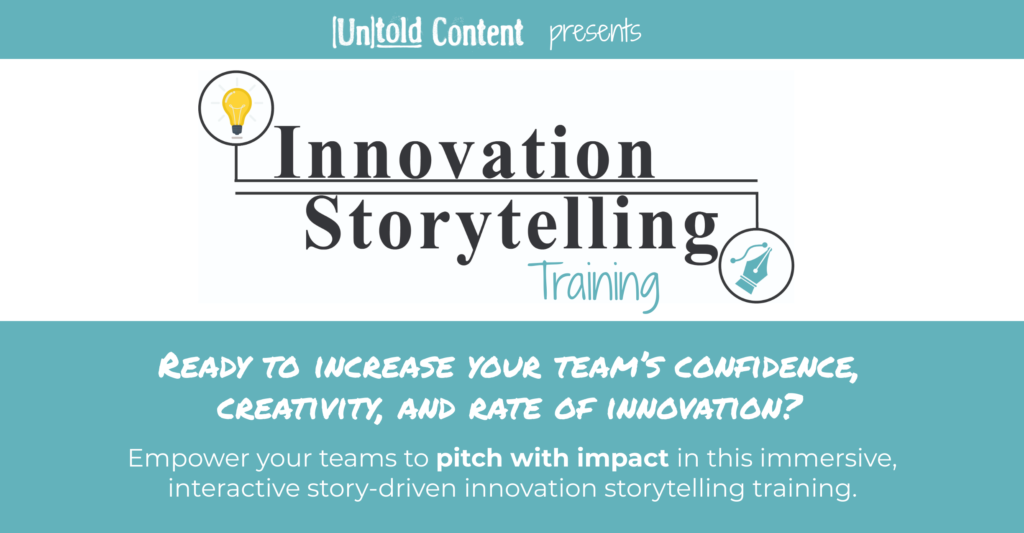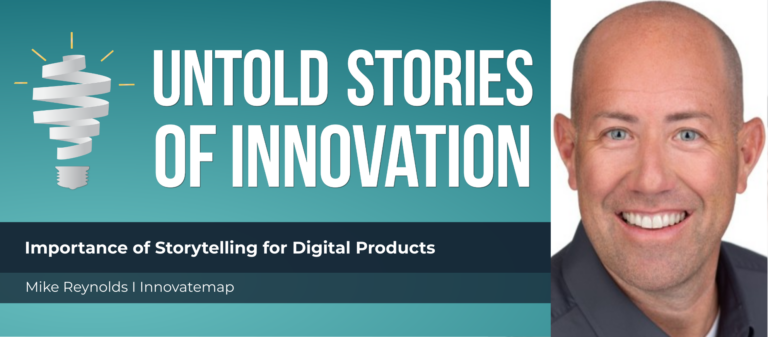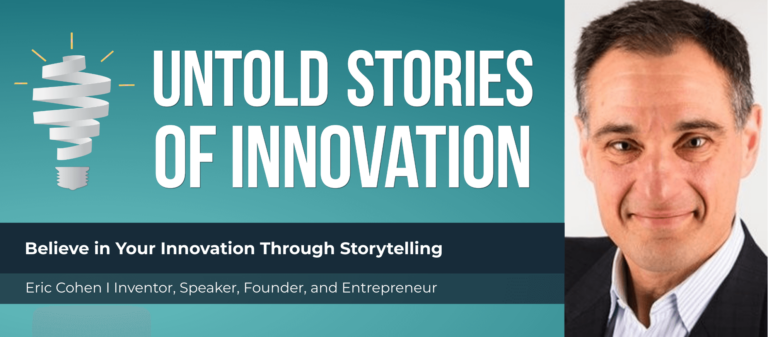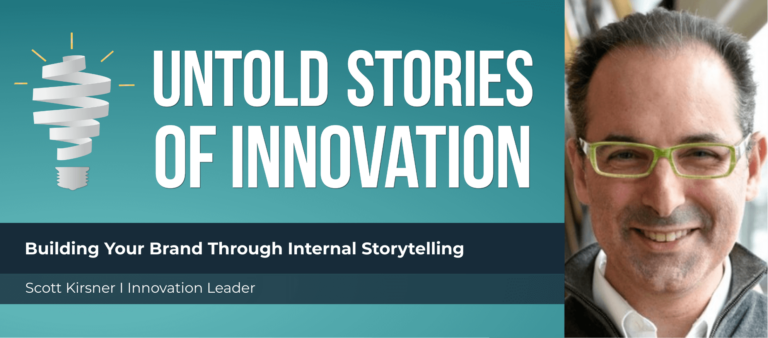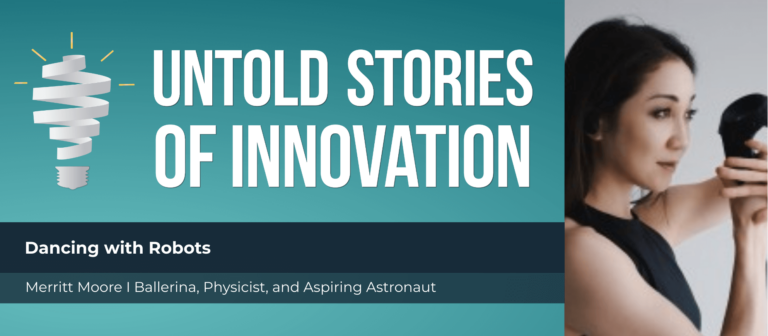Leading Women in Technology with Laura Marino
Untold Stories of Innovation
“For the leaders that are trying to promote innovation, to encourage a team to do something that may be difficult and new and hard. I think you need to show passion. You need to show empathy. You need to tell the story of why this is important, why there is going to be impact, and then you need to make the team feel that they are empowered but supported.” - Laura Marino
From today’s episode you’ll learn:
We speak with Laura Marino, Chief Product Officer at TrueAccord and former Senior Vice President of Product at Lever. She shares with us the power of diversity and inclusion within innovation, such as the variety of different perspectives, better decision making, and increased creativity. She shares stories of her previous work in advocating for more women in a male-dominated room, and her current work with a non-profit called Leading Women in Technology, which is dedicated to promoting woman-led leadership. Laura dives into the importance of storytelling inside of the technology industry, discussing how she got where she is today and how driven she is to get other women a “seat at the table.”

Laura Marino is a Chief Product Officer with extensive experience in product management, M&A analysis, and definition of corporate strategies and she was the former Senior Vice President of Product at Lever. Laura is passionate about scaling companies and product organizations. She is currently Chief Product Officer at TrueAccord, a Lecturer at Stanford University, and a serving board member of Leading Women in Technology, a non-profit dedicated to promoting women leadership
This episode is powered by Untold Content’s Innovation Storytelling Training. Increase buy in for your best ideas in this immersive and interactive, story-driven experience. Where your teams refine storytelling techniques for their latest projects, prototypes and pitches—and get inspired by 25 epic examples of impactful innovation stories.
Katie [00:00:04] Welcome to Untold Stories of Innovation, where we amplify untold stories of insight, impact and innovation. Powered by Untold Content. I’m your host, Katie Trauth Taylor. Our guest today is Laura Marino. She is Senior Vice President of Product at Lever and a board member of Leading Women in Technology. Laura, I’m so grateful to have this conversation with you today. And thank you for being here.
Laura [00:00:32] It’s a pleasure to be here. Thank you for inviting me.
Katie [00:00:35] So tell us about your personal story of innovation and how you got started.
Laura [00:00:41] I have been leading product teams in large and small software companies in Silicon Valley for many years. But my personal story began a while ago when I was a young woman in Colombia and I decided to study civil engineering. Civil engineering is pretty technical, very male dominated career, and I was one of only four women in my class. But I am the fifth child in a family of seven children with only one boy and six girls. And my parents always raised us with the expectation that we would all be professionals. I had sisters, one is a doctor, two architects, engineers. So for me, going into civil engineering seemed very natural. So after I graduated from civil engineering in Colombia, I came to the US to get a master’s degree at Stanford University. And I then went on to work for nine years in civil engineering but developing software models for reservoir operations. And then I realized that really the software industry is where the exciting innovation was happening and I wanted to move into the software industry. So I essentially took our family savings. My husband was very supportive. I pretty much left him being a single parent of our five year old son and our three year old daughter. And I went back full time to Stanford for another degree, this time in management, science and engineering. Which allowed me to then move into the software industry and I started working in different companies, and I have experience in a broad range of technologies from speech recognition to customer relationship management to technology. But as I moved along in my career, I really could see how underrepresented women and minorities were in technology. So I started making an effort to build balance teams and mentor women and encourage women to be in technology and take bigger roles. I’ve been in companies where I had to build teams, so I had the chance to start promoting that. And then four years ago, I joined the board of Leading Women in Technology, which is a nonprofit dedicated to helping women develop the skills that they need to advance into leadership roles. And two years ago, I joined Lever. It’s a company that is developing software to help organizations attract and recruit talent. But it’s what’s wonderful about Lever is that it’s a very diverse company. Our CEO is a woman. We have about 50 percent of managers are women, 40 percent of engineers are women. And what is great about labor is that the product itself, as we build the product to help organizations scale their teams, we are also providing functionality to help them build more balanced, more diverse teams.
Katie [00:03:51] Absolutely. Diversity and inclusion is such a central aspect of your whole story from a personal and a professional standpoint. That image of you as a young college student being one of only four women and then the image of you depending on being able to depend on your husband to care for young children while you focused on this new career pathway and now you being in a role of mentoring women, it’s incredibly inspiring. I’d love to hear more about Lever and why diversity and inclusion matter to recruitment, matter to innovation more broadly as well.
Laura [00:04:33] Well, I do believe that innovation is a team sport. You really need a team to get the ideas and develop those ideas to make them a reality. And diverse teams can have a lot more innovation because when you’re combining people that have different backgrounds, that they come from different cultures that have different experiences, what you have is a team that can look at problems and how to solve them in a much more comprehensive and more creative way. And bringing those new ideas to market also is helped by having diverse people who understand different parts of the market because they may represent different groups with different challenges and different interests. So I do think that for companies, having diverse teams is not just the right thing to do is the smart thing to do from a business perspective. And never from the very beginning. The founders really founded a company that was meant to be very diverse across all angles. So we have people from different cultures, different gender orientations, different geographies. And it’s a wonderful experience because you really learn a lot from being exposed to people who had different experiences than the one you had. So as we’ve built this software to really help companies attract the talent, which is now one of the most challenging and strategic priorities for companies, the talent market right now is very, very competitive. It has changed a lot from where it was 10, 15 years ago, where people would stay in a company for 10 years, where companies just would post a new job posting and people would apply to them. Now it’s really much more competitive. People stay at companies for a shorter period of time. Companies need to be hiring all the time and they need to be reaching out to people who may not be applying to their job postings. So we’ve built software that really helps those companies manage the Antoin talent relationship from establishing a relationship with people who may not have considered the company to attracting them, to bringing them on board and eventually resurfacing people who at one point might have had a conversation with the company and were not hired but already have a relationship. And what we also do is provide the customer, our customers, with the ability to also track the diversity of this funnel of people that they are bringing in and attracting to track the diversity in their goals in terms of. Bringing more diversity to different departments or to different locations and be able to report on that because then they can be much more specific is where they target their efforts to source and attract people. And so it is really something that we feel we’re helping companies in both ways, really helping them attract more people, but also attract more diverse teams.
Katie [00:07:42] In some of the conferences that I’ve attended around diversity and inclusion and different sectors and innovation, I’m thinking of one in particular I attended recently on diversity and inclusion in health care innovation. There was a lot of conversation around accountability and why it’s so challenging for organizations to really walk the walk and not just talk the talk around metrics and really put goals in place and then being holding themselves accountable to those goals to create more diverse teams and to have more diverse individuals rise into leadership positions. And so what I love about the innovation work that you’re doing is you’re sort of inserting that accountability Lever, if you will, forgive the bad pun. But, you know, you’re inserting that into a software solution that is already so needed when it comes to recruitment and retention of talent. But you’re also using that power for a specific purpose and then giving organizations an opportunity to to to have visibility around those goals. It’s so incredibly important.
Laura [00:08:57] Absolutely. We also try to be very much a thought leader in this space because, as I said, Lever itself is a fabulous example of what a diverse company looks like. So we do have a lot of thought leadership that we try to share with our customers and with the industry in general about how to go about it.
Katie [00:09:17] Yes, and really, again, walking the walk, being able to say we’ve implemented this ourselves and here’s how we’ve done so in a cross-cultural team, in a highly diverse team with people of different nationalities and cultural backgrounds. How does storytelling and story sharing work? Do you think it’s more important or less important in an organization that is diverse?
Women in Technology: Diversity and Storytelling
Laura [00:09:42] I think that storytelling is important in every organization. I don’t think that there is too much of a difference. I think, though, that your ability to tell a compelling story is going to be increased by having a diverse team because that team will be able to help tell a more complete story. So the way I think of innovation and innovation is essentially bringing a new idea to reality that’s going to improve something. Innovation can be in new products, but it also can be in processes. But what is critical is not just to have an idea is to have an idea that actually becomes a reality and that requires buy in. And that’s where storytelling becomes so incredibly powerful because storytelling not only allows people to communicate the idea in a way that is compelling, but it also allows people to get the buy in from the team that needs to help make that idea a reality. If they can see what the benefit of bringing that idea to reality is, if they can empathize and relate to the benefits that this idea is going to bring, they will be more willing to be part of making it a reality. And I think that that’s where storytelling has a huge opportunity. And of course, if you have a diverse team, your ability to tell the story in a way that’s compelling to a broader set of people is going to be stronger.
Katie [00:11:15] Absolutely. One of the topics that we cover in our innovation storytelling workshops is empathy. And we have analyzed thousands of different innovation stories and saw empathy as a key driver. If you if your innovation story doesn’t elicit or utilize empathy, then it’s going to miss the mark. And one of the functional ways that we bring empathy into our innovation stories is to really use it to check our assumptions. And I think that’s where getting multiple voices and multiple perspectives at the table when you’re trying to figure out which which way to speak to the impact or the evidence that your solution matters so that your interesting concept or new product matters is to pull in different voices, empathize with them, and show that diversity as a way of checking some of the assumptions that we first have when we try to craft our innovation story.
Laura [00:12:15] Absolutely. And the reality is that the market now is very. Even here in the US, you have such a range of people and cultures that you really need to be building a story that’s compelling to the entire market, not just to the people who think like you and look like you. And that’s where kind of having a diverse team helps from the very beginning.
Katie [00:12:38] Internally, tell me more about your process of getting buy in and what that looks like when there are many different perspectives and and everyone’s trying to sort of make sure they’re speaking the same language, as it were, with the other people inside of your startup?
Laura [00:12:57] Well, one of the things that we find very powerful is telling the story also from the perspective of our customers. What we’re trying to do is build software, build tools that are going to help our customers. So it’s very important to get the whole team a little bit in the shoes of our customers. We recently had our sales kickoff and we were sharing some of the things we’re doing in the product that’s innovative. And the way that I ended up introducing one of the things that we’re doing that’s new was telling the story of one of our customers who’s today facing challenges with their processes for recruiting because they have a complex process. And so the way for me to introduce how exciting it is that what we’re doing is going to help this person was to first tell the story of his pain points. What is it that he’s struggling with? Why is it bad for him and for his team? The current situation is not great. Once you have the team kind of in those shoes, then you can share. But this is what we’re going to be doing next. And this is how what we’re doing next is going to enable them to address those pain points. Then you really have the team now much more focused on what we’re doing is really helping our customers. And that’s what is going to be most exciting for the team to really move forward and get this work done. So I think that really being able to tell the story from the perspective of the customer was very powerful.
Katie [00:14:30] Yes. And to me, what’s so powerful about that example, too, is that it was coming from you as an organizational leader. You were demonstrating how to tell an innovation story that puts the customer’s voice at the front of it. And so then you’re modeling that and that’s another power of storytelling and story sharing. It’s not just that we’re actually using that technique to make an innovation make sense or matter to someone, but we’re also then using it to create internal cultures that continue to do that same thing. So hearing you as an innovation leader, speak to your product development teams and to other people inside the organization by using that strategy now they are empowered to think in those same ways and incorporate the voice of the consumer and customer into all of their narratives. And I think that’s such an important strategy. I’m so glad you brought that up for increasing buy-in and helping people remember the mission and align their individual efforts with the organization’s larger vision and goals.
Laura [00:15:35] Right. The other strategy that works is to make sure and depending on what kind of what you’re trying to present, what you’re trying to get the audience to relate to. But I have quite a bit of experience scaling startups and startups that are transitioning from what I call the early stage and are starting to see fast growth. They really need to go through a lot of changes and those changes are difficult. And I have been invited to give some presentations. I was in the Women in Product Conference talking to a group of women product leaders, telling them a little bit about what to expect, what those changes are. And what I could see resonating was I was describing based on my experience and based on my experience from other companies, very much what they were facing. And then I was trying to explain to them what type of changes they needed to be prepared for as they get their organization and the company ready for scaling. And what was very rewarding for me was at the end of the presentation, I had several people come to me, say, oh, my God, you were describing my world. You were describing my day to day life right now for a company that is starting to go through that. So being able to tell this story in a way that people can relate to, that they can understand, that they can see themselves in that situation, then you can bring them along more easily into it. So now be prepared. These are the things that you’re going to need to start doing now so that you’re ready for this stage that your company’s entering. But if you don’t get them to relate at the beginning of where they are, you may not be able to bring them on that journey.
Katie [00:17:23] Could you bring an example or two to life from that presentation?
Women in Technology: Startups
Laura [00:17:28] Oh, sure. So when you think of startups and if you’re in Silicon Valley, everybody talks about moving fast, iterating testing. Well, that works fine when you are a very early start up, you have a small group of people, they talk to each other all the time. The engineering team is just focused on getting new things out. You have a couple of early customers who are willing to try things and that allows you to move very quickly. That’s part of the strategy that companies have in that early stage to get to what we call product market fit. But once the company has secured initial success, now you have a product that has resonated in the market and all of a sudden you’re getting a lot more customers. You have a lot more of your companies growing now. You’re not 20 people or 50 people. Now you’re one hundred or one hundred and fifty. That kind of informal way of doing things doesn’t work anymore. Communication that used to be very agile when you were small completely starts breaking down when you have a hundred and fifty people versus 20. So you need to start doing things like putting in place more processes. And process is a bad word for some young start ups. I mean, there’s this ideal process. This is going to slow us down. But as you face this fast growth, if you don’t put some processes in place, you’re just going to end up in pure chaos. Yes. And I think that when I talk a little bit about how the evolution of the communication that was very agile started getting chaotic, a lot of people start seeing that in terms of the product. There’s also evolutions that have to happen because initially fine for engineering and product, you just focus on getting new things out so that the customer sees more and more value in the product. But once you start getting larger customers and big customers, especially if you’re serving businesses, you need to start paying attention to things like scalability, like performance, like making sure that there are tools for the customers to configure the product. It’s not just the end features that needs a change in approach to how the team is developing and how they are prioritizing. And it has to be done in a way that’s kind of planned. Otherwise, you may end up with a product that has a lot of features and starts breaking because it wasn’t designed to be scalable enough to take on so many new customers. So there’s changes pretty much in every area of the company that need to start happening. And I think that the companies that don’t realize that are the ones that start running into trouble. And I do have some examples of companies that actually were very successful at the beginning, didn’t pay attention to that and failed because when they are faced with fast growth, they don’t have the performance and they start failing. So I am able to kind of start the story with where companies typically are when they are starting to face that fast growth. And it is very typical. So many of the people in the audience kind of say, yes, that’s us. That’s exactly what’s happened.
Katie [00:20:39] I’ve been nodding, you can’t see me, but I’ve been nodding my head this entire time because on a personal level, as a founder, I can so relate to that feeling of the things that used to work on a smaller, more agile team aren’t working as we scale and scale and scale. So I feel you and because it’s so powerful to hear that personal connection from the start, I notice you’re using a second person point of view to say you might experience this, you might be feeling this, you might be along this trajectory. And I’ve seen so many others like you experience these same shifts. Thank you for sharing some insight into that. I also just think it’s so powerful for startups to be able to hear the experiences that others have gone through and see where the failures have happened and try to learn from them to make failure something we’re more comfortable talking about in order to produce more rapid learning. What are your thoughts sort of on how we create innovation cultures that are more comfortable with talking about failures?
Laura [00:21:44] Well, I think Silicon Valley has really promoted that. So I think that there’s a lot about that, I think that in many ways there’s a need for a balance. I I believe that sometimes the idea that failure is good and just go fail fast actually may be counterproductive because it allows for people to not think through doing enough of their understanding of what the problem is, but they are solving and whether you see a big problem. And so there’s kind of a balance. You want people to be willing to try new ideas. But I don’t think that if you want to encourage something that is like just try whatever and if it fails, it fails and we’ll try. The next thing I’m particularly aware of that because I work on software for Business-to-business. You cannot just throw stuff at businesses because there’s a cost of failure and the cost of failure is there for the customers as well. A customer that is willing to try your solution is going to have to invest time and resources. And so you want to make sure that you and your team are doing as much research and analysis and understanding before throwing something out. So I think that I absolutely believe that people should not be penalized if they fail by trying something. But I do think that it’s important to make sure that you are encouraging people to do their due diligence, to really try to understand before just kind of throwing and seeing if it sticks.
Katie [00:23:19] Yes, I couldn’t agree more. We had Untold work with quite a few health tech startups, and especially in health care, the move fast break things philosophy is dangerous. You know, we’re talking about people’s lives and their health and their well-being. And so that really sort of goes against the Hippocratic Oath to do no harm. So we have to give a lot of thought and carefully consider what risks are worth taking. And I think there’s still I do believe there are still ways to move fast, but be comprehensive, I guess, about how we assess whether something is worth.
Laura [00:23:59] Yes, there are ways of testing things and validating things. And you’re absolutely right that depending on the industry, you have to be more or less conservative. I think that a lot of the concept of just move fast, break things fast is very applicable to direct to consumer where consumers try something they like it or not, but they’re not very much negative consequences as you start moving toward complex software for companies and then kind of all the way to things like health care, it has to be done differently. There has to be a lot more sort of understanding and planning, but it doesn’t mean that you cannot try new things and that you cannot innovate.
Katie [00:24:40] Completely agree. Tell us about some of the innovation stories either coming out of Lever, different strategies you’re using to communicate your innovations to potential customers and what seems to be resonating or perhaps coming out of leading women in technology.
Laura [00:24:58] Yeah, I actually probably have two interesting stories. One is actually coming from back in the days when I was in speech recognition when today speech recognition is ubiquitous. Right. You have it in your phone. You have it in you almost and everybody speaks to their machines. There’s nothing strange about that. When I first started in speech recognition, we were really the pioneers. It was a very kind of strange thing to do to think that you would speak to your phone and the phone would understand and respond. So we were building out speech recognition systems, speaker verification systems to verify who you were based on your voice. And we were selling those systems to large organizations to help them with their automated customer care. Instead of having the press one, press two, three, you would be able to speak to the system. And instead of having to remember a password or you would you just would say it’s Laura Marino and the system would recognize that it was me. But it was such a novel thing in selling this to banks that were very, very conservative or large. Organizations that were very conservative were difficult. And so really it was very much about telling the story of what their customers’ experience was. And we would be kind of telling them, like, do you know what the experiences for me as a customer of a bank when I call into your system and I go through 10 different menus of press, one, if you want this to be one, does not enter your passcode, which I never remember. So it wasn’t a really painful experience. And so we had to kind of remind them of this is what you have today. This is what your customers are experiencing today when they call your bank. Now, let’s look at what the experience could be like. If I can call in and I say, this is Laura Martin or this is my phone number. And with that, you already know that it is me. And then I can go and say, I need to know what my balance is or I need to know how much credit is left in my credit card, how much easier is that? And so that’s what started being compelling. And again, we were really pioneering something that people didn’t believe, but being able to tell the story from the perspective of how painful it was, what they had encouraged them to say, yes, let’s try this. We need to see if we can improve the life of our customers.
Katie [00:27:30] Yes, so always keep your customers’ customers in mind, right, because if that’s not their priority, that they’re probably missing something and it always should be their priority. So making their hero yours and being able to extrapolate the value and at the same time show value to them directly as well. So you’re kind of especially in B2B, there’s always that additional layer of communication you have to be thinking about. That’s right.
Leading Women in Technology
Laura [00:28:01] The other piece and you were asking about leading women in technology and leading women in technology offers a year long program that women go through. And we bring expert speakers who help women with a bunch of different things, like how to predict credibility, how to be better at change management, how to increase confidence so that you can step up to do more. But one of the things that to me is very interesting is one of our best speakers, Carol, so sexy. She talks about how women can step up and really feel confident that they can speak up and have a bigger role. And I think that what makes her session so powerful is that she tells her own story. And you look at her and she’s this amazing, charismatic woman, but she tells the story of her being a really, really shy young woman who would not even lift up her face to say hi to people because she was so shy. And she walks you through kind of what she was, what woke her up, how she changed. And that story what happens with that is that it makes it real for the women in the room saying if she was able to change that way, of course, I can change and I can use the tools that she’s giving me to improve. But I think that if she just gave the tools without telling her story, the women in the room would not necessarily feel that, oh, I can do it, too. I am going to change. And I think that that’s where I see kind of in my mind, an example of a really powerful story, because it really encourages people to action is not just like, oh, yeah, I got this great list of tools of things that I should do and I probably should try them. They walk away saying, hey, this does make a huge difference.
Katie [00:29:53] It takes so much vulnerability to admit to the things that we’re afraid of in front of other people, but I think that’s also where we generate the best kinds of mentorships and relationships, is when we’re there for one another. And we feel as though we can be candid about the things that we’ve struggled with or the times where we felt like an outsider. I love the mission of leading women in technology because it seems like you’re tackling some of those challenges head on right now.
Laura [00:30:24] And it’s been a great program. Again, it’s not just targeted for women who are in technology. That’s kind of a bit of a legacy. But we have women who are lawyers, women who are accountants, but they all are dealing with the reality that they may be working in organizations where women don’t have enough. I say that women are not in leadership, in part because they don’t know how to actually go and ask for that, how to present themselves as being the logical choice for the next opportunity leadership.
Katie [00:30:55] I see, and so it’s really quite a bit of practical advice about breaking down some of the systematic oppression, honestly, that have been in place for so long that have sort of made it more challenging for women to rise into leadership positions, not only but especially in STEM and technology fields.
Laura [00:31:18] Yes, because there are some minority of women in some of the limitations, I would say are self imposed by women because of our culture, our tradition and so on. So I think that it is important to, first of all, realize what are the things that sometimes hold us back. And it’s not necessarily that you have a male coworker who’s more aggressive is just that his attitude towards things is different than yours, having been raised as a woman. And you start realizing a little bit those differences, you can start addressing that.
Katie [00:31:47] You’ll probably appreciate this, but at Untold, we recently collaborated with one of our clients, Crossover Health in Silicon Valley, and we conducted the first meta analysis on imposter syndrome or what the medical literature called imposter phenomenon, and found that it equally impacts men and women and that it even more so impacts minorities like that to feel like an impostor in your professional life. And the other interesting finding was that it’s age independent. So it doesn’t matter if you’re a young professional or if you’re at the end of your career, you’ll still have a proclivity to having feelings of being an impostor.
Laura [00:32:31] Absolutely. I think that that is true and I do believe that that’s true for male and female as well. I think that in my career, what I have learned is that it’s very, very powerful to have male allies. I was very fortunate in my career that I not only had, of course, the support of my parents and then my husband was incredibly supportive. But in a lot of my early stage of the career, I worked with VPs of engineering and research who were just so kind of supportive of me. And I look back and I think that that’s one of the things that gave me the confidence to really kind of continue moving forward in my career. And so I think that there’s a whole lot to be said about women also figuring out how to find and create those male allies who will be supportive and helpful and who themselves may be struggling with some of those same kind of imposter syndrome challenges.
Katie [00:33:32] Yes, yes, and I think there’s so much responsibility to as as we grow into successful professionals and have more responsibilities or perhaps our managing or leading others to continue to make it part of our mission, to encourage them and to trust their judgments and to mentor without micromanaging. You know, because I think all those of us who care so much about the work that we do, we’re going to have the proclivity toward feeling self judgment and criticizing and sort of worrying about whether we are meant to be where we are. And if that is also coming from our mentors or our leaders or our managers, then it just sort of quadruples the effect of of our self-doubt and really trying to find those mentors and managers and leaders and essentially prioritizing that as an area where leaders can continue to grow and help make imposter syndrome a little more understood and and not ignore the way that it has such a such a strong impact on our productivity.
Laura [00:34:44] And I think that there is a lot to be said about type of management that’s supportive, but it’s also that tends to challenge people to do more, because if it’s a manager, you’re supportive of the person, convince them like you’re here because we thought you were good enough to be here. But now I believe that you can do even more. That’s a way to challenge them, to try more. But knowing that they have support and I think that that’s where you really can stretch people and get them to become more confident, they are successful in doing something that was bigger than they initially thought, but they are not terrified of if I fail, I’m going to get fired. That’s where people start feeling comfortable saying, oh, I can do it, I’ll try. I think I can do it. And there’s a lot on the management to really encourage that type of attitude.
Katie [00:35:32] I love that. Do you have any other advice that you would give to innovators as they prepare to share their great ideas?
Women in Technology: Innovation Advice
Laura [00:35:39] I think you mentioned something about being vulnerable. I think that there’s a balance between as a leader you want to come through is confident you need to come through, especially if you don’t show the passion for what you’re doing is going to be very hard for a team to want to follow you. But at the same time, they need to know that you are approachable and that you’re vulnerable, that you are not kind of the one who knows everything. But instead, as a team, the team is going to be able to succeed. And it’s a leader that you’re easier to guide, to be a sounding board, to provide direction, but is not the person who’s going to be just telling them exactly what to do and judging them if they are not doing it in the right way. [00:36:21]So I would say that for the leaders that are trying to promote innovation, to encourage a team to do something that may be difficult and new and hard, I think you need to show the passion. You need to show empathy. You need to tell the story of why this is important, why there is going to be impact, and then you need to make the team feel that they are empowered but supported.
Katie [00:36:44] Absolutely. That is so powerful. Laura, thank you so much for this conversation. I’m so grateful that we got to chat. And if you are interested, you can follow on social media at Lever app and you can follow LWOP leadership to learn more about leading women in technology. And Laura Marino, I’m so excited to continue learning more from you, and I’m grateful for the time that you’ve given to the innovation community today with your thought.
Laura [00:37:15] Thank you, Katie, and thank you for your entire organization. I think that you’re doing a great job just kind of promoting these conversations.
Katie [00:37:22] Thank you, Laura for talking to me.
Laura: OK, bye.
Katie: Thanks for listening to this week’s episode. Be sure to follow us on social media and add your voice to the conversation. You can find us at Untold Content.
You can listen to more episodes of Untold Stories of Innovation Podcast.
*Interviews are not endorsements of individuals or businesses.

